air condition Lexus HS250h 2010 Owner's Manual
[x] Cancel search | Manufacturer: LEXUS, Model Year: 2010, Model line: HS250h, Model: Lexus HS250h 2010Pages: 611, PDF Size: 11 MB
Page 3 of 611
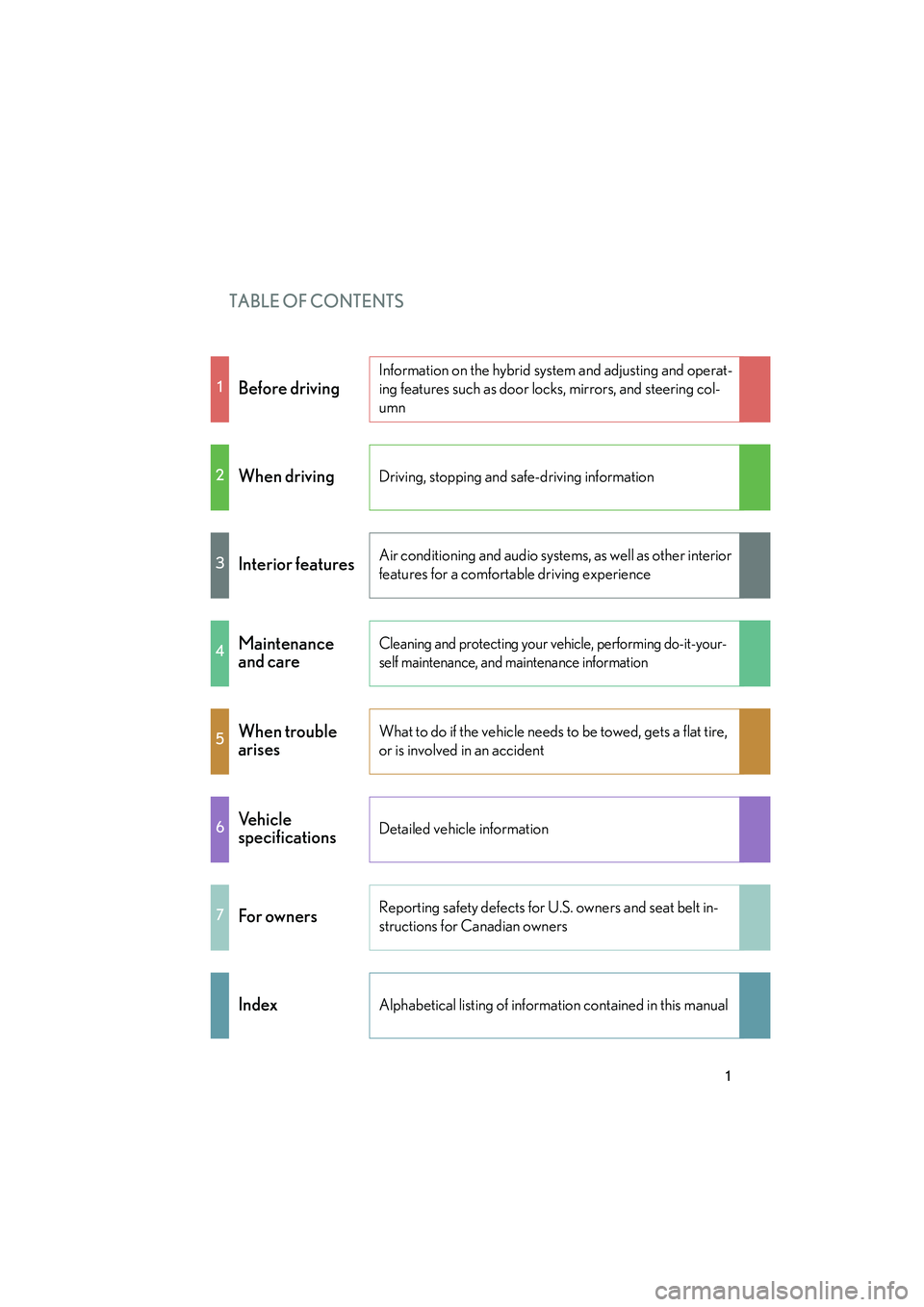
TABLE OF CONTENTS
HS250h_U_75033U(Canada)
1
1Before driving
Information on the hybrid system and adjusting and operat-
ing features such as door locks, mirrors, and steering col-
umn
2When drivingDriving, stopping and safe-driving information
3Interior featuresAir conditioning and audio systems, as well as other interior
features for a comfortable driving experience
4Maintenance
and careCleaning and protecting your vehicle, performing do-it-your-
self maintenance, and maintenance information
5When trouble
arisesWhat to do if the vehicle needs to be towed, gets a flat tire,
or is involved in an accident
6Ve h i c l e
specificationsDetailed vehicle information
7For ownersReporting safety defects for U.S. owners and seat belt in-
structions for Canadian owners
IndexAlphabetical listing of information contained in this manual
Page 4 of 611
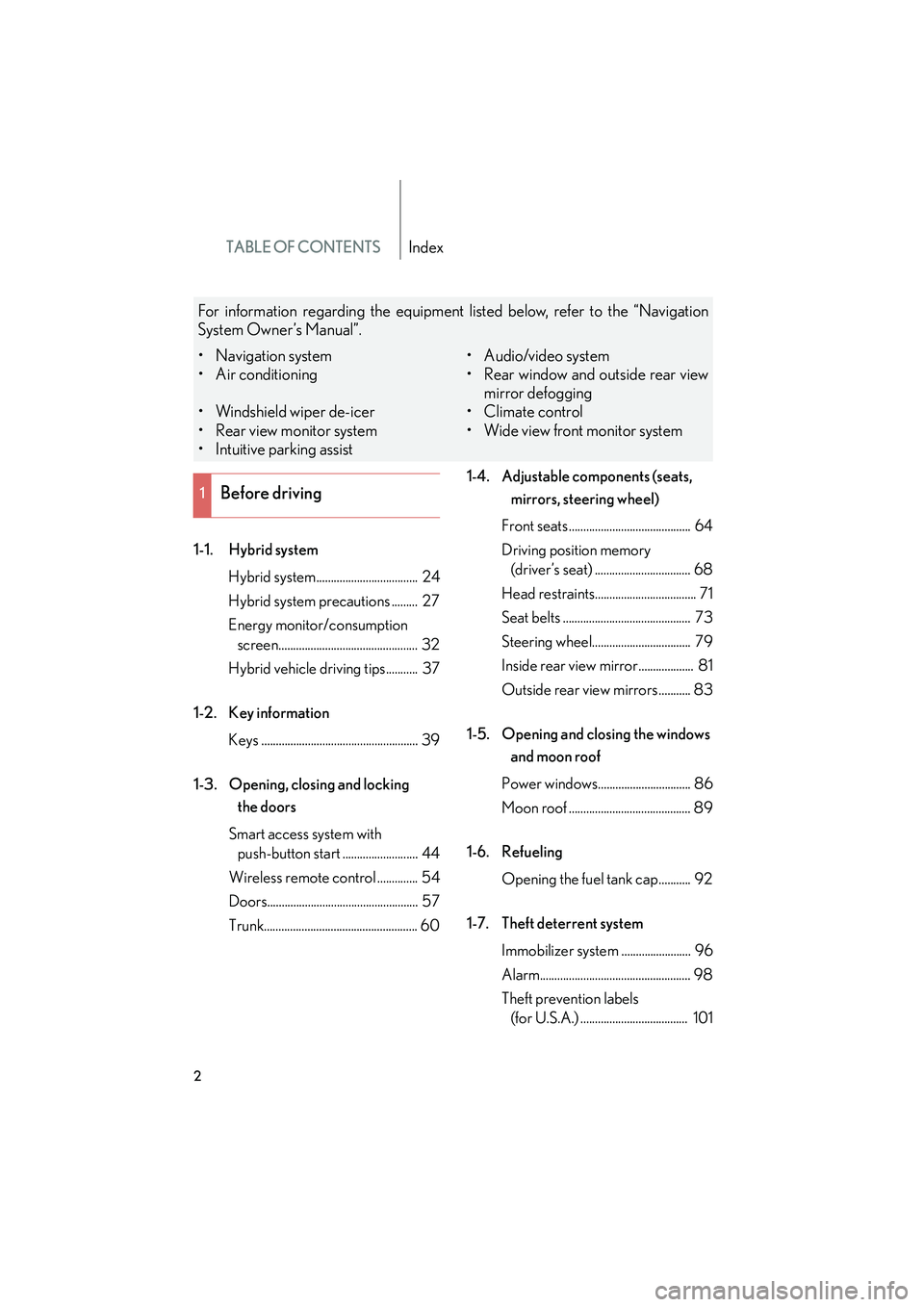
TABLE OF CONTENTSIndex
HS250h_U_75033U(Canada)
2
1-1. Hybrid systemHybrid system................................... 24
Hybrid system precautions ......... 27
Energy monitor/consumption screen................................................ 32
Hybrid vehicle driving tips........... 37
1-2. Key information Keys ...................................................... 39
1-3. Opening, closing and locking the doors
Smart access system with push-button start .......................... 44
Wireless remote control .............. 54
Doors.................................................... 57
Trunk..................................................... 60 1-4. Adjustable components (seats,
mirrors, steering wheel)
Front seats.......................................... 64
Driving position memory (driver’s seat) ................................. 68
Head restraints................................... 71
Seat belts ............................................ 73
Steering wheel.................................. 79
Inside rear view mirror................... 81
Outside rear view mirrors ........... 83
1-5. Opening and closing the windows and moon roof
Power windows................................ 86
Moon roof .......................................... 89
1-6. Refueling Opening the fuel tank cap........... 92
1-7. Theft deterrent system Immobilizer system ........................ 96
Alarm.................................................... 98
Theft prevention labels (for U.S.A.) ..................................... 101
1Before driving
For information regarding the equipment listed below, refer to the “Navigation
System Owner’s Manual”.
• Navigation system
• Air conditioning
• Windshield wiper de-icer
• Rear view monitor system
• Intuitive parking assist • Audio/video system
• Rear window and outside rear view
mirror defogging
•Climate control
• Wide view front monitor system
Page 5 of 611
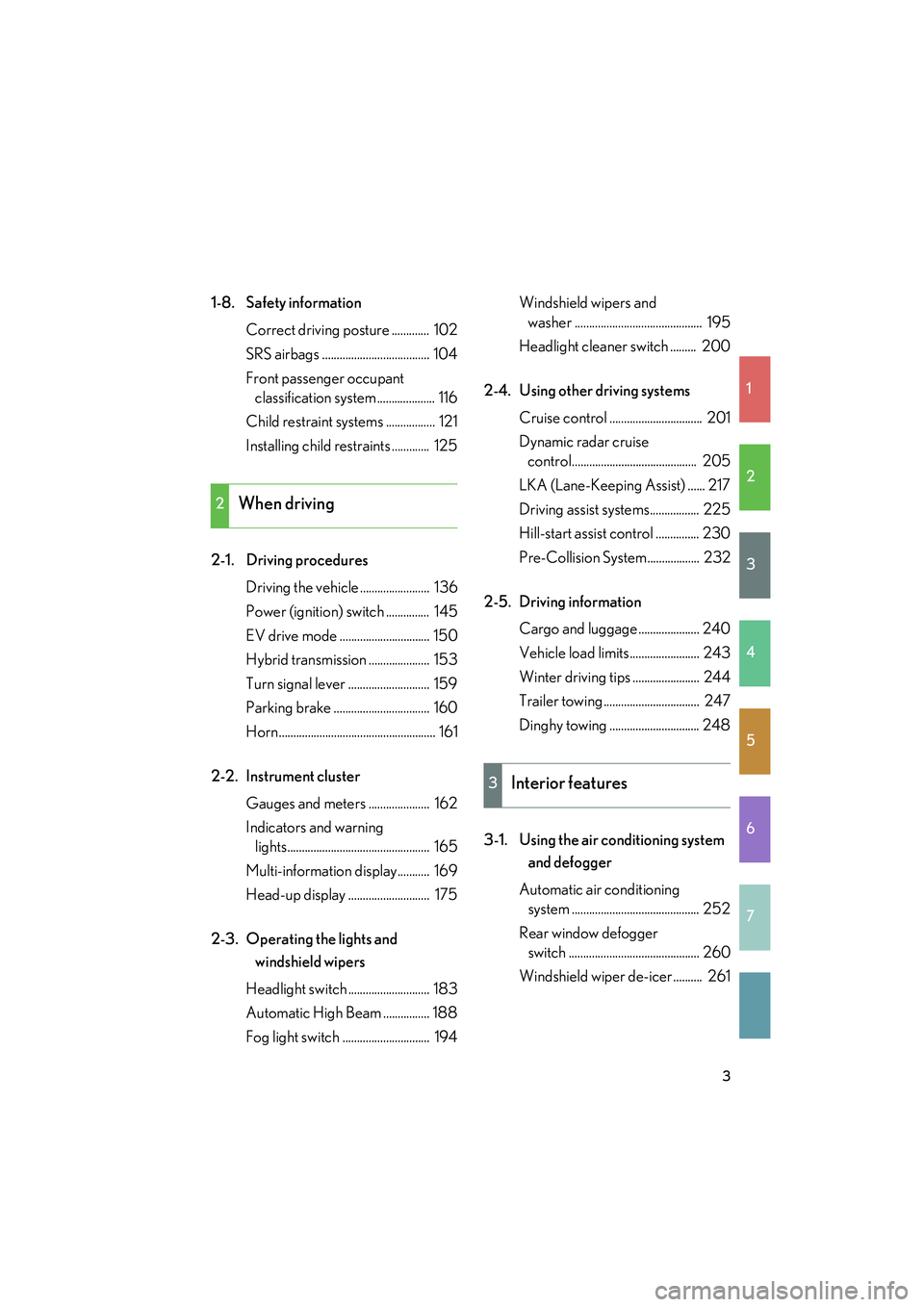
1
2
3
4
5
6
7
HS250h_U_75033U(Canada)
3
1-8. Safety informationCorrect driving posture ............. 102
SRS airbags ..................................... 104
Front passenger occupant classification system .................... 116
Child restraint systems ................. 121
Installing child restraints ............. 125
2-1. Driving procedures Driving the vehicle ........................ 136
Power (ignition) switch ............... 145
EV drive mode ............................... 150
Hybrid transmission ..................... 153
Turn signal lever ............................ 159
Parking brake ................................. 160
Horn...................................................... 161
2-2. Instrument cluster Gauges and meters ..................... 162
Indicators and warning lights................................................. 165
Multi-information display ........... 169
Head-up display ............................ 175
2-3. Operating the lights and windshield wipers
Headlight switch ............................ 183
Automatic High Beam ................ 188
Fog light switch .............................. 194 Windshield wipers and
washer ............................................ 195
Headlight cleaner switch ......... 200
2-4. Using other driving systems Cruise control ................................ 201
Dynamic radar cruise control........................................... 205
LKA (Lane-Keeping Assist) ...... 217
Driving assist systems................. 225
Hill-start assist control ............... 230
Pre-Collision System.................. 232
2-5. Driving information Cargo and luggage ..................... 240
Vehicle load limits........................ 243
Winter driving tips ....................... 244
Trailer towing ................................. 247
Dinghy towing ............................... 248
3-1. Using the air conditioning system and defogger
Automatic air conditioning system ............................................ 252
Rear window defogger switch ............................................. 260
Windshield wiper de-icer .......... 261
2When driving
3Interior features
Page 7 of 611
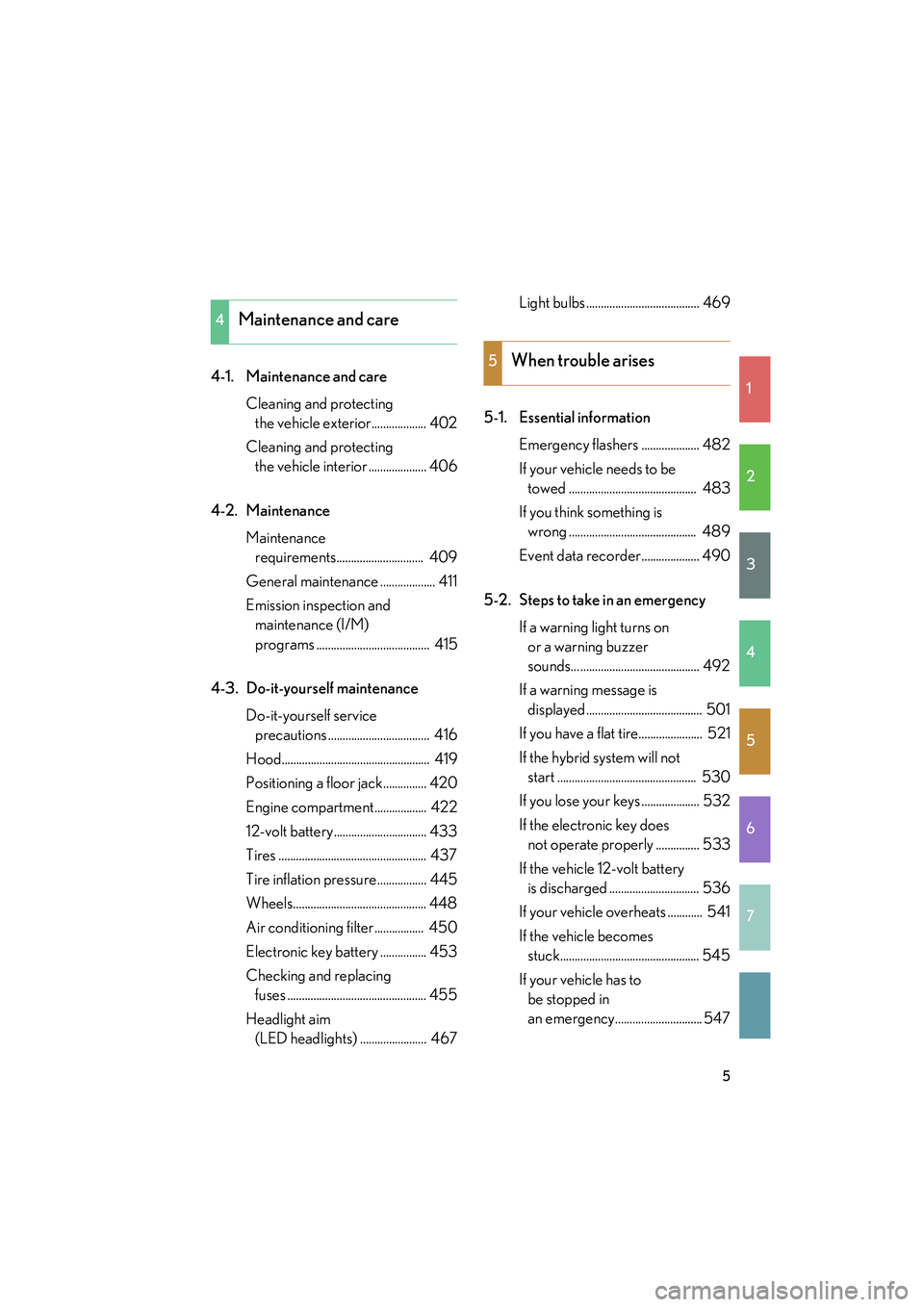
1
2
3
4
5
6
7
HS250h_U_75033U(Canada)
5
4-1. Maintenance and careCleaning and protecting the vehicle exterior................... 402
Cleaning and protecting the vehicle interior .................... 406
4-2. Maintenance Maintenance requirements.............................. 409
General maintenance ................... 411
Emission inspection and maintenance (I/M)
programs ....................................... 415
4-3. Do-it-yourself maintenance Do-it-yourself service precautions ................................... 416
Hood................................................... 419
Positioning a floor jack ............... 420
Engine compartment.................. 422
12-volt battery................................ 433
Tires ................................................... 437
Tire inflation pressure................. 445
Wheels.............................................. 448
Air conditioning filter................. 450
Electronic key battery ................ 453
Checking and replacing fuses ................................................ 455
Headlight aim (LED headlights) ....................... 467 Light bulbs ....................................... 469
5-1. Essential information Emergency flashers .................... 482
If your vehicle needs to be towed ............................................ 483
If you think something is wrong ............................................ 489
Event data recorder.................... 490
5-2. Steps to take in an emergency If a warning light turns on or a warning buzzer
sounds... ......................................... 492
If a warning message is displayed ........................................ 501
If you have a flat tire...................... 521
If the hybrid system will not start ................................................ 530
If you lose your keys .................... 532
If the electronic key does not operate properly ............... 533
If the vehicle 12-volt battery is discharged ............................... 536
If your vehicle overheats ............ 541
If the vehicle becomes stuck................................................ 545
If your vehicle has to be stopped in
an emergency.............................. 547
4Maintenance and care
5When trouble arises
Page 17 of 611

HS250h_U_75033U(Canada)
15
Without navigation system
∗: If equipped
*1: Refer to “Navigation System Owner's Manual”.*2: For vehicles with a navigation system, refer to the “Navigation System Owner’s Manual”.
Rear window and
outside rear view
mirror defogger
switch
P. 260Emergency flasher
switch
P. 482
Security indicator
P. 96, 98
Clock P. 373
Air
conditioning
system
P. 252
With navigation systemNavigation system
*1
Air conditioning
system
*1
Emergency flasher
switch
P. 482Clock*1
Security indicator
P. 96, 98
Rear window and out-
side rear view mirror
defogger switch
*1
Page 29 of 611
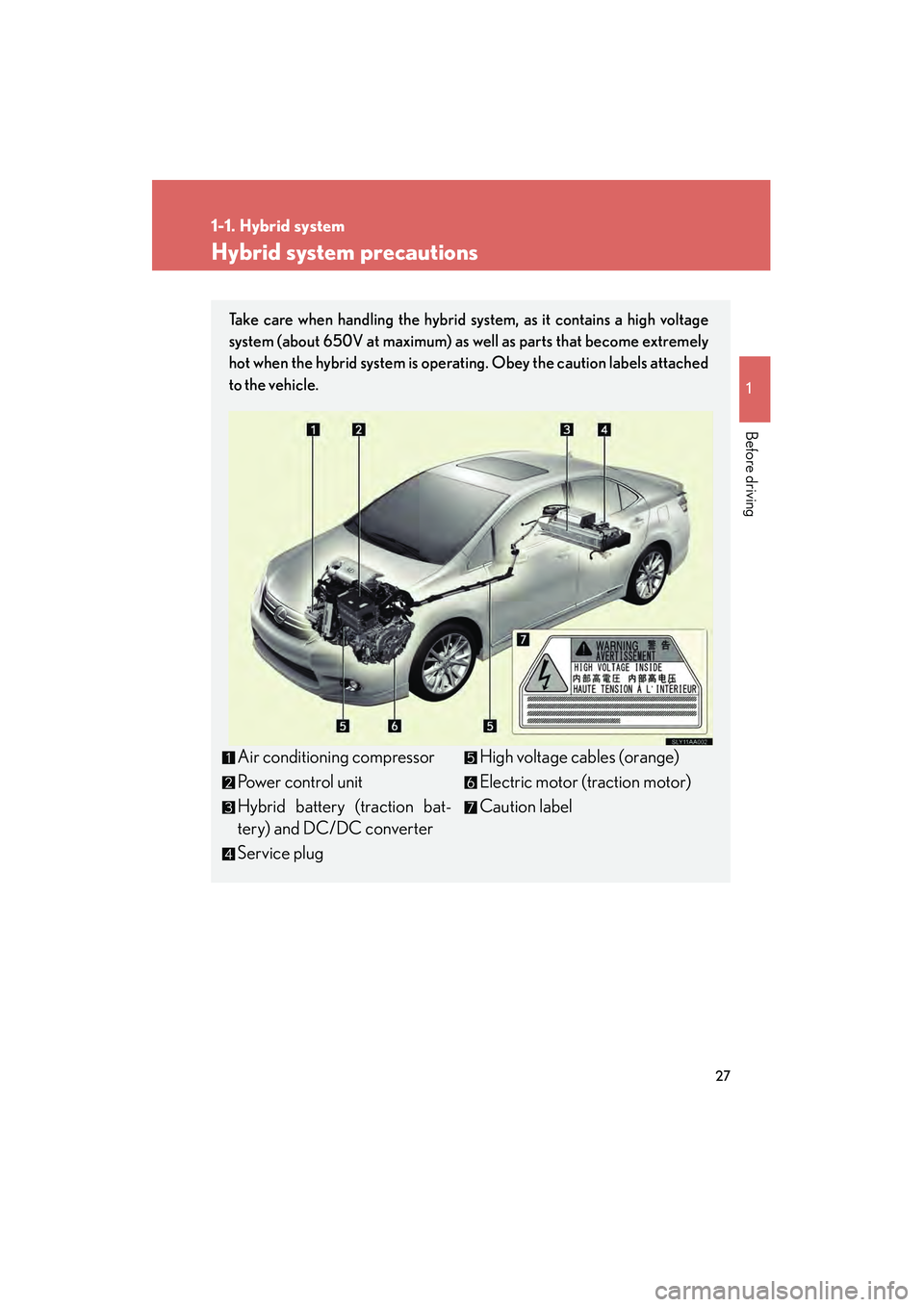
27
1
1-1. Hybrid system
Before driving
HS250h_U_75033U(Canada)
Hybrid system precautions
Take care when handling the hybrid system, as it contains a high voltage
system (about 650V at maximum) as well as parts that become extremely
hot when the hybrid system is operat ing. Obey the caution labels attached
to the vehicle.
Air conditioning compressor
Power control unit
Hybrid battery (traction bat-
tery) and DC/DC converter
Service plug High voltage cables (orange)
Electric motor (traction motor)
Caution label
Page 39 of 611
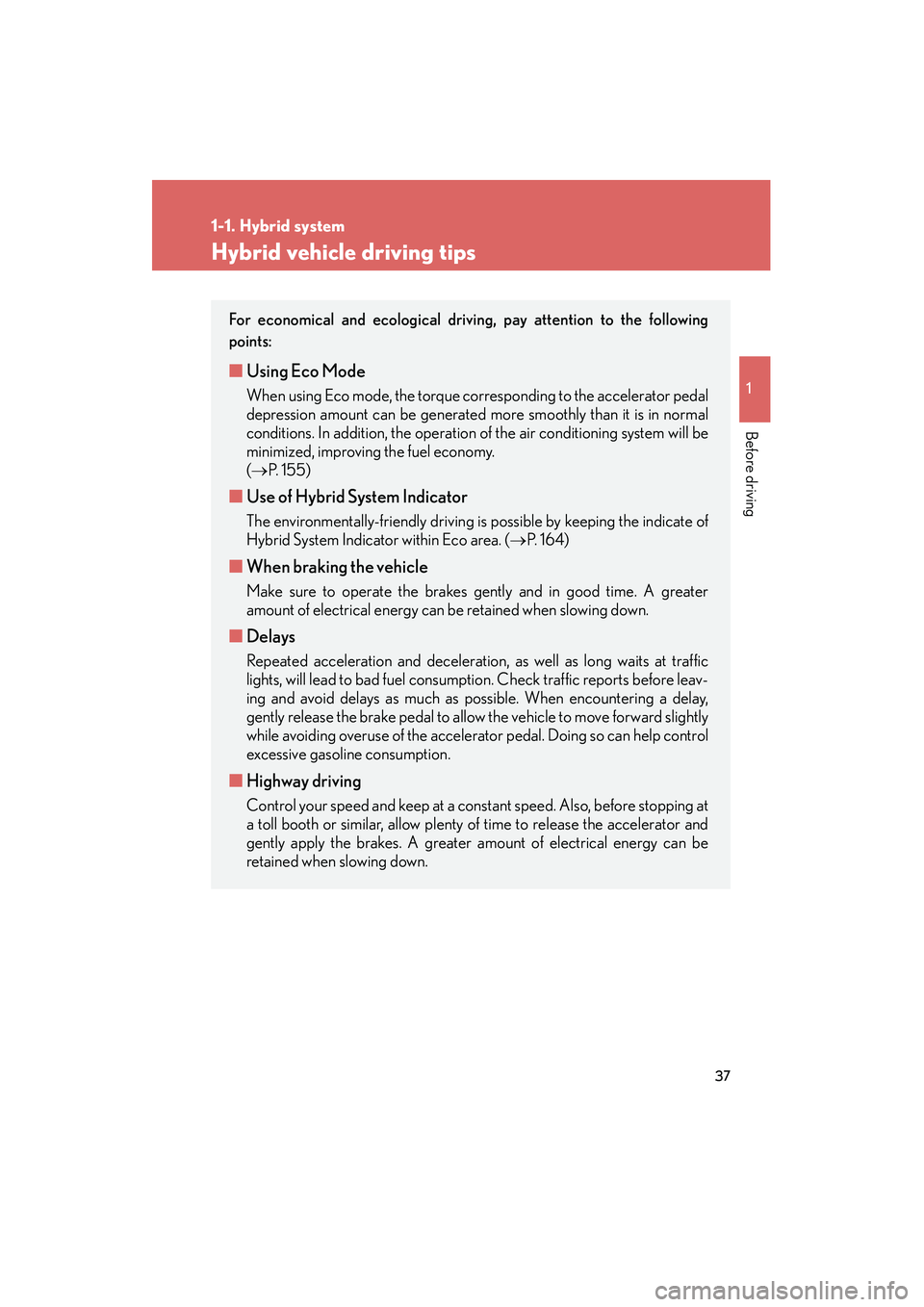
37
1
1-1. Hybrid system
Before driving
HS250h_U_75033U(Canada)
Hybrid vehicle driving tips
For economical and ecological driving, pay attention to the following
points:
■Using Eco Mode
When using Eco mode, the torque corre sponding to the accelerator pedal
depression amount can be generated more smoothly than it is in normal
conditions. In addition, the operation of the air conditioning system will be
minimized, improving the fuel economy.
( → P. 1 5 5 )
■Use of Hybrid System Indicator
The environmentally-friendly driving is possible by keeping the indicate of
Hybrid System Indicator within Eco area. ( →P. 1 6 4 )
■When braking the vehicle
Make sure to operate the brakes gently and in good time. A greater
amount of electrical energy can be retained when slowing down.
■Delays
Repeated acceleration and deceleration, as well as long waits at traffic
lights, will lead to bad fuel consumption. Check traffic reports before leav-
ing and avoid delays as much as po ssible. When encountering a delay,
gently release the brake pedal to allow the vehicle to move forward slightly
while avoiding overuse of the accelera tor pedal. Doing so can help control
excessive gasoline consumption.
■ Highway driving
Control your speed and keep at a constant speed. Also, before stopping at
a toll booth or similar, allow plenty of time to release the accelerator and
gently apply the brakes. A greater amount of electrical energy can be
retained when slowing down.
Page 40 of 611
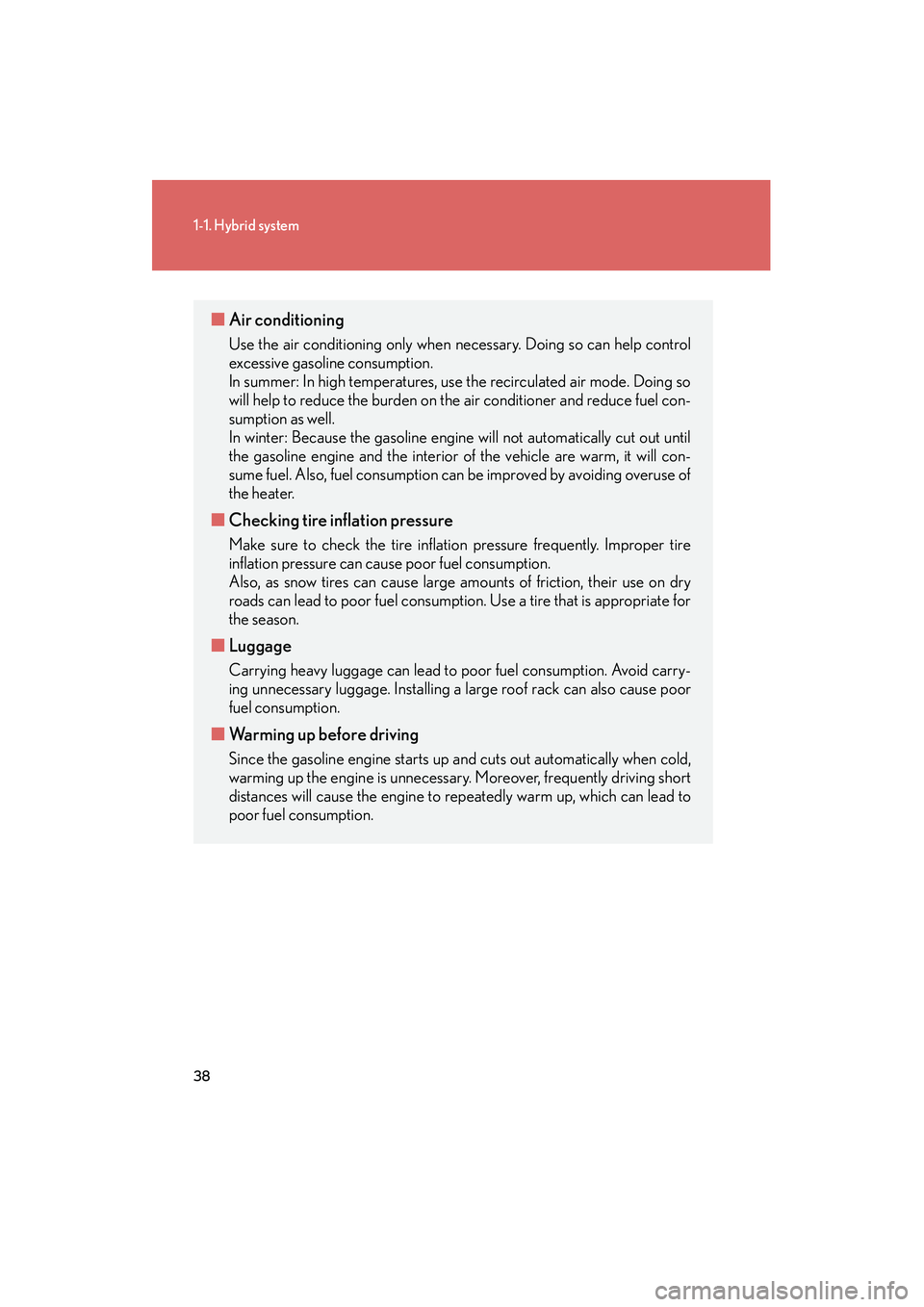
38
1-1. Hybrid system
HS250h_U_75033U(Canada)
■Air conditioning
Use the air conditioning only when necessary. Doing so can help control
excessive gasoline consumption.
In summer: In high temperatures, use the recirculated air mode. Doing so
will help to reduce the burden on the air conditioner and reduce fuel con-
sumption as well.
In winter: Because the gasoline engine will not automatically cut out until
the gasoline engine and the interior of the vehicle are warm, it will con-
sume fuel. Also, fuel consumption can be improved by avoiding overuse of
the heater.
■ Checking tire inflation pressure
Make sure to check the tire inflation pressure frequently. Improper tire
inflation pressure can cause poor fuel consumption.
Also, as snow tires can cause large amounts of friction, their use on dry
roads can lead to poor fuel consumption. Use a tire that is appropriate for
the season.
■Luggage
Carrying heavy luggage can lead to poor fuel consumption. Avoid carry-
ing unnecessary luggage. Installing a large roof rack can also cause poor
fuel consumption.
■Warming up before driving
Since the gasoline engine starts up and cuts out automatically when cold,
warming up the engine is unnecessary. Moreover, frequently driving short
distances will cause the engine to repeatedly warm up, which can lead to
poor fuel consumption.
Page 51 of 611
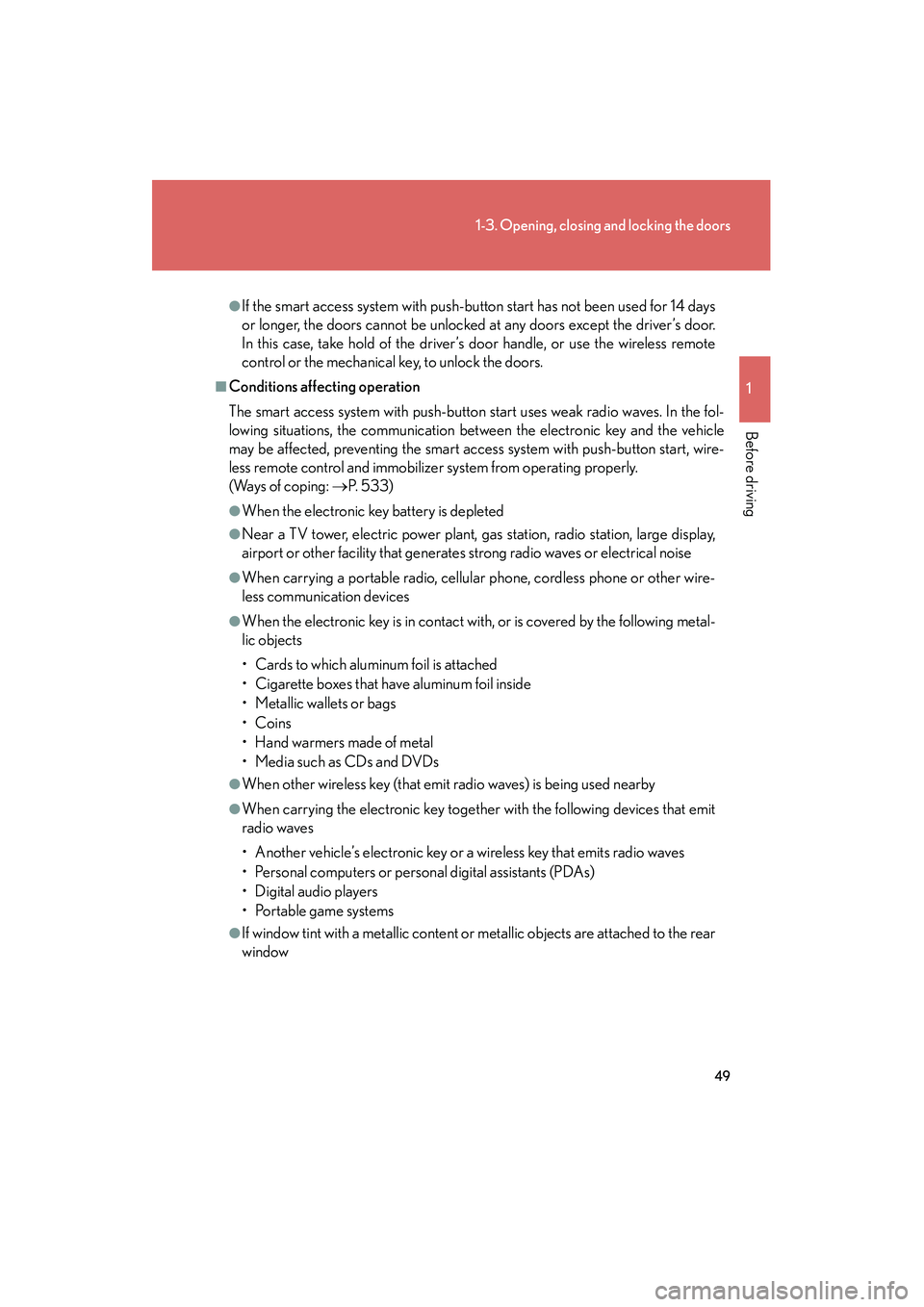
49
1-3. Opening, closing and locking the doors
1
Before driving
HS250h_U_75033U(Canada)
●If the smart access system with push-button start has not been used for 14 days
or longer, the doors cannot be unlocked at any doors except the driver’s door.
In this case, take hold of the driver’s door handle, or use the wireless remote
control or the mechanical key, to unlock the doors.
■Conditions affecting operation
The smart access system with push-button start uses weak radio waves. In the fol-
lowing situations, the communication between the electronic key and the vehicle
may be affected, preventing the smart access system with push-button start, wire-
less remote control and immobilizer system from operating properly.
(Ways of coping: →P. 5 3 3 )
●When the electronic key battery is depleted
●Near a TV tower, electric power plant, gas station, radio station, large display,
airport or other facility that generates strong radio waves or electrical noise
●When carrying a portable radio, cellular phone, cordless phone or other wire-
less communication devices
●When the electronic key is in contact with, or is covered by the following metal-
lic objects
• Cards to which aluminum foil is attached
• Cigarette boxes that have aluminum foil inside
• Metallic wallets or bags
•Coins
• Hand warmers made of metal
• Media such as CDs and DVDs
●When other wireless key (that emit radio waves) is being used nearby
●When carrying the electronic key together with the following devices that emit
radio waves
• Another vehicle’s electronic key or a wireless key that emits radio waves
• Personal computers or personal digital assistants (PDAs)
• Digital audio players
• Portable game systems
●If window tint with a metallic content or metallic objects are attached to the rear
window
Page 109 of 611
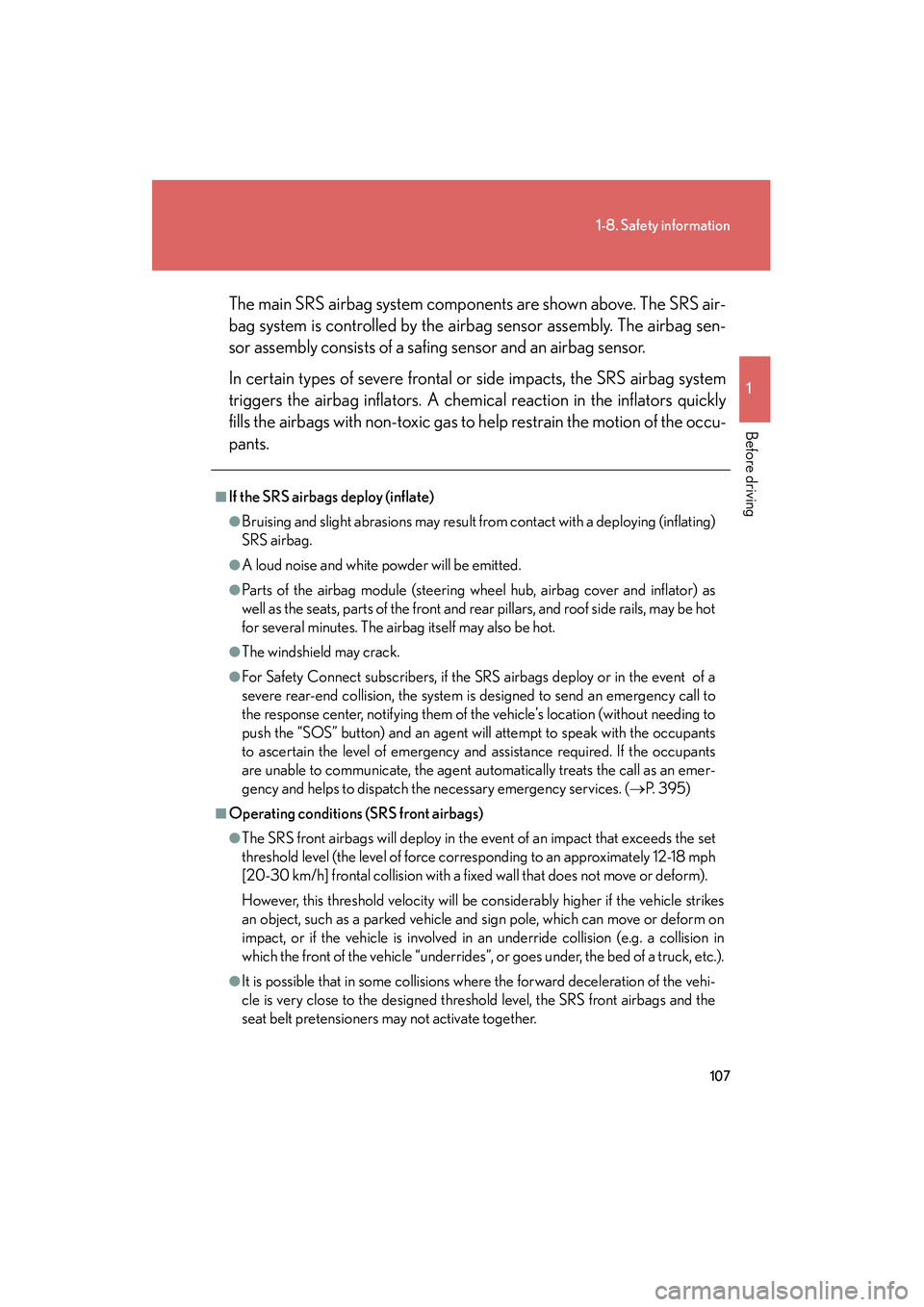
107
1-8. Safety information
1
Before driving
HS250h_U_75033U(Canada)The main SRS airbag system components are shown above. The SRS air-
bag system is controlled by the airbag sensor assembly. The airbag sen-
sor assembly consists of a safing sensor and an airbag sensor.
In certain types of severe frontal or side impacts, the SRS airbag system
triggers the airbag inflators. A chemical reaction in the inflators quickly
fills the airbags with non-toxic gas to help restrain the motion of the occu-
pants.
■If the SRS airbags deploy (inflate)
●Bruising and slight abrasions may result from contact with a deploying (inflating)
SRS airbag.
●A loud noise and white powder will be emitted.
●Parts of the airbag module (steering wheel hub, airbag cover and inflator) as
well as the seats, parts of the front and rear pillars, and roof side rails, may be hot
for several minutes. The airbag itself may also be hot.
●The windshield may crack.
●For Safety Connect subscribers, if the SRS airbags deploy or in the event of a
severe rear-end collision, the system is designed to send an emergency call to
the response center, notifying them of the vehicle’s location (without needing to
push the “SOS” button) and an agent will attempt to speak with the occupants
to ascertain the level of emergency and assistance required. If the occupants
are unable to communicate, the agent automatically treats the call as an emer-
gency and helps to dispatch the necessary emergency services. (
→P. 3 9 5 )
■Operating conditions (SRS front airbags)
●The SRS front airbags will deploy in the event of an impact that exceeds the set
threshold level (the level of force corresponding to an approximately 12-18 mph
[20-30 km/h] frontal collision with a fixed wall that does not move or deform).
However, this threshold velocity will be considerably higher if the vehicle strikes
an object, such as a parked vehicle and sign pole, which can move or deform on
impact, or if the vehicle is involved in an underride collision (e.g. a collision in
which the front of the vehicle “underrides”, or goes under, the bed of a truck, etc.).
●It is possible that in some collisions where the forward deceleration of the vehi-
cle is very close to the designed threshold level, the SRS front airbags and the
seat belt pretensioners may not activate together.